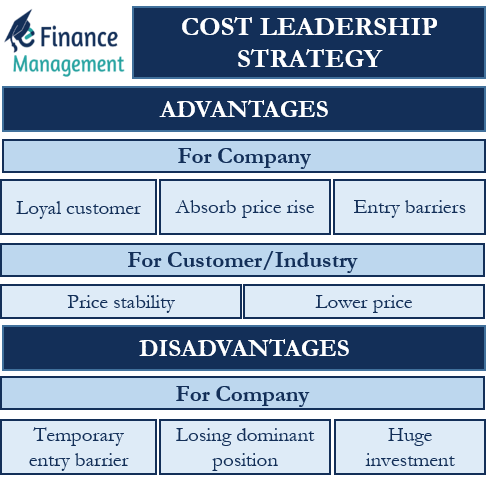Michael E. Porter, in his 1985 book “Competitive Advantage: Creating and Sustaining Superior Performance,” discussed four competitive strategies. These strategies are – Cost Leadership, Differentiation, and Focus strategy (Cost Focus and Differentiation Focus). According to Porter, each of these strategies is capable of giving a competitive advantage to a company in a market. Like with any other thing, each of these strategies has been their own advantages and disadvantages. In this article, we will take a look at the advantages and disadvantages of the Cost Leadership strategy.
Before we detail the advantages and disadvantages of the Cost Leadership strategy, let’s understand the Cost Leadership strategy.
Cost Leadership Strategy – What it is?
A company following this strategy uses economies of scale and makes production efficient enough to reduce the product and service costs lower than that of rivals. This strategy basically means leading an industry in terms of the cost of production.
Ikea and Walmart are very good examples of firms practicing this strategy. These companies make huge profits by mass-selling their products for less than the competitors.
Cost Leadership Strategy: Advantages
Below are the advantages of the Cost Leadership strategy:
For Company
Loyal Customers
Low costs always encourage customers to stick to a brand unless other brands are offering something extra. It ensures that the firm has a strong and more market presence.
Absorb Price Rise
A firm enjoying cost leadership is in a better position to absorb any increase in price from suppliers. Their low-cost structure helps them to absorb the price rise without marginally passing the same to the end user.
Entry Barriers
This strategy helps to create significant entry barriers to discourage new entrants. It helps existing companies in the industry.
For Customers/Industry
Price Stability
It helps to bring price stability in the industry.
Lower Price
Customers get the product or service at a lower price.

Cost Leadership Strategy: Disadvantages
Below are the disadvantages of the Cost Leadership strategy:
For Company
Huge Investment
Implementing a low-cost strategy requires a company to make big investments to boost its production capabilities. So, such investments make this strategy expensive to implement.
Temporary Entry Barrier
A key downside of this strategy is that competitors can easily imitate it. Once the competitors are able to achieve similar cost advantages, the entry barrier is broken. It could result in the cost leader losing its competitive advantage in the short run.
Losing Dominant Position
Companies adopting this strategy focus mainly on reducing per-unit costs. It could lead to overlooking other crucial factors, such as research and development, studying market trends, and the macro environment. Overlooking these factors could lead to the company losing its hold on the market in the long term.
Final Words
Cost Leadership is a very effective strategy. A company that is able to successfully achieve this strategy could ensure long-term success. The biggest risk, however, to a company following this strategy is that rivals could imitate the cost reduction strategies. Thus, it is very crucial for the cost leader to continuously find ways to reduce the cost.
RELATED POSTS
- Advantages and Disadvantages of Differentiation Strategy
- Porter’s Generic Strategies – Meaning, Types, and Example
- Cost Leadership – The Why & How of It
- Advantages and Disadvantages of Multidomestic Strategy
- Profit Strategy: Meaning, Assumption, Limitations and More
- Ansoff Matrix – Meaning, Strategies, Steps and Examples

